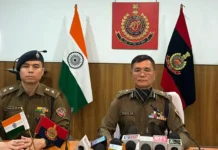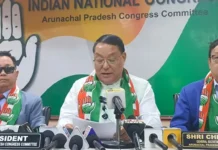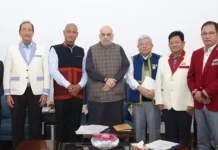[ Amar Sangno ]
Arunachal now is no longer Arunachal then. Our state was born with five districts, named after the mighty rivers Kameng, Subansiri, Siang, Dibang, Lohit and Tirap, in 1972. Today it has 25 districts, including the recently-created ones – Lepa-Rada, Shi-Yomi and Pakke-Kessang.
Communication bottlenecks and the ‘isolation syndrome’ in terms of development are popular bargaining chips nowadays for demanding the creation of new districts in Arunachal. The demands are based on the argument of inequitable distribution of funds leading to backwardness and deprivation of area. For the people concerned, a new district means a gateway to socio-economic development and job opportunities. More importantly, it would ensure assured allocation of funds to a particular area.
However, if creation of new districts were the sole mantra to develop a place, then each circle headquarters would dream of becoming a district headquarters, and each village a circle headquarters.
The fact, however, is that the current trend of creating new districts is not based on principles of rationality and easy governance but rather on political appeasement of communally-driven forces that propound the argument of equal development and job opportunities, disregarding the financial implications on the government coffers.
Kamle and Pakke-Kessang districts were created possibly because of insurmountable pressure from the All Nyishi Youth Association and the Nyishi Elite Society on the government, with support from the MLAs. Similar tactics were applied by the Galo Welfare Society and the local MLA to carve out Lepa-Rada from Lower Siang district. For Shi-Yomi, too, the local MLA’s role was instrumental. The creation of Siang district was buoyed up by its community-based organizations.
The population of a particular area does not fall under the criteria of the District Reorganization Act. Had that been the case, Dibang Valley, with a total population of merely 7,272, would not have become a district in 2001. Pakke-Kessang has a total population of 12,242, including 2,148 households, 74 villages, a 4,200 sq km area, and three zilla parishads. Shi-Yomi’s population is 13,310, with four circle headquarters (Mechuka, Tato, Pidi and Monigong). Leppa-Rada has a population of 21,134, with a size of 1,673 sq kms, comprising four circle headquarters, six zilla parishad members, 54 anchal segments, and 72 villages.
Indeed, some of the districts were created in genuine consideration of deprivation in terms of development and job opportunities; however, a few were carved out because of political compulsion to create safer enclosures for the legislators as well as the communities.
Articulating the people’s aspirations, then Mechuka ADC Tongge Loya in his note mentioned that “a separate Shi-Yomi district, with headquarters at Tato, is expected to fulfill the required economic development and full employment for the people.”
Seemingly, our legislators and community leaders have adopted the principle of protectionism, without realizing that Arunachal is a true manifestation of the great Indian diversity as hundreds of ethnic groups are living in our state.
If at all creation of a district is a parameter for developing an area and uplifting the socioeconomic status of a particular community, then the Puroik community, which is sparsely spread in East Kameng and Kurung Kumey districts among the Nyishis and the Sajolangs, also deserves a district, and so do the Tutsas and Yobins who live among the Wanchos and the Tangsas in Longding and Changlang districts.
The Hrusso (Aka) and Sajolang communities of West Kameng and East Kameng districts have been demanding Bichom district, and they almost succeeded this year; however, arguments over the district’s headquarters played spoilsport in their momentum.
Apparently, each tribe is asking for a castle of its own. With the MLAs, too, craving to turn their constituencies into districts, it should not come as a surprise if we end up with 60 legislative assemblies operating as 60 districts in the days to come. Who, then, would be left to carry forward the ‘Team Arunachal’ baton?
The recurring and non-recurring expenditure involved in Pakke-Kessang district is Rs 14,60,14,710 (fourteen crore sixty lakhs fourteen thousand seven hundred and ten); Rs 19,60,71,870 (nineteen crore sixty lakhs seventy-one thousand eight hundred and seventy) in Shi-Yomi; and Rs 18,38,39,870 (eighteen crore thirty-eight lakhs thirty-nine thousand eight hundred and seventy) in Lepa-Rada.
Similar financial implications were involved with regard to Namsai (Rs 16, 22,07,298), Kra Daadi (Rs 62,21,5000), Siang (Rs 72,4,65,100), and Lower Siang (Rs 31,400000).
“Inequitable distribution of funds is the only reason why the people are clamouring for new districts – to liberate themselves from deprivation. Unless fund distribution is streamlined, such trend will continue as the government has opened a floodgate,” said a former bureaucrat.
“Bureaucrats will be happier as there will be more promotional scope in the new districts; but the question is, are people really happy to have new districts without adequate infrastructures?” he added.
Arunachal Pradesh Congress Committee (APCC) president Takam Sanjoy was quick in castigating the Pema Khandu government for creating districts only on paper and without sufficient infrastructure in place. However, the former MP himself was among the leaders who were instrumental in creating Kra-Daadi district in February 2015.
Going by the pace of districts’ creation, Marshall McLuhan’s phrase about the world being a global village is no longer applicable to Arunachal Pradesh. Rather, we will have more physical boundaries among the tribes than do the European countries. Obviously, the Arunachal then, with five districts, was more harmonious than the Arunachal now with 25; at least people did not talk about tribes in those days.





